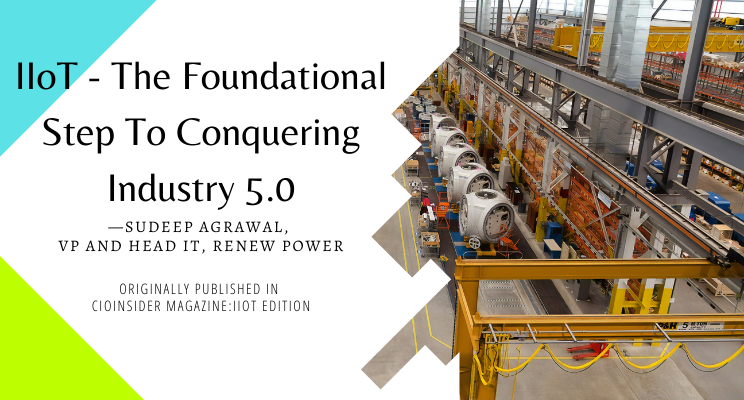This article was first published in CIO Insider India.
Industry 4.0: a breath of fresh air in a world and time that believed in all muscle, sweat, and labour to accomplish great manufacturing results. It was not too much of an over-haul, just minor tweaks that let machines speak to the people, and often, to each other. It was a concept that scared manufacturers and made them wonder how many people it would put out of work. But little did they realise that it was the future, and it would only help its human counterparts better. The initial fear of smart machines and devices stemmed from the fact that the IIoT-powered equipment could perform better than human brains by consistently weighing data on the given parameters and communicating the same in real-time to embedded systems.
The Growth Curve of IIoT in Recent Times
As data became an essential part of manufacturing, machines turned from mere equipment to smart devices that could absorb information, compute them, and deliver information to human users. Further involvement from AI meant that these machines could potentially make their own decisions.
This growth curve of IIoT has been rapid in the sight of more recent global happenings. One such event is our new household name-COVID-19. While most industries struggled to survive the pandemic, manufacturers took Industry 4.0 very seriously to make a difference in their businesses. In fact, the IIOT market is expected to be worth USD110.6 billion by 2025, growing at a CAGR of 7.4 percent during the forecast period. This was mainly owing to the positive demand shock that spread across the world during the pandemic.
Benefits of IIoT in Recent Times
The growth of Industry 4.0 ushered in potential like machine utilisation, efficiency, preventive failures, and alerts to avoid out-ages. With the use of Business Intelligence tools, data drawn from machines can showcase patterns and trends that can help diagnose or predict incidents. The most significant advantage of IIoT is predictive maintenance, which enhances the productivity of devices on the field. It also enables digital performance monitoring and can be fed back into actual usage parameters to drive effective product development.
IIoT in Supply Chains and Warehouse Management
A survey of manufacturing companies that have digitised their processes by the American Society for Quality (ASQ) showed that these companies increased their efficiency by 82 percent, reduced product defects by 49 percent, and saw a 45 percent increase in customer satisfaction. So, what is their secret?
When it comes to machine utilisation and increasing throughput, IIoT has been key in amplifying warehouse management, under-standing market demands, and maintaining harmony across the supply chain from soup to nuts. This shift has helped in promoting supply chain management. IIoT and embedded sensors add to the traceability of products and improve logistics processes to optimise supply chain operations like demand forecasting and shipment scheduling.
As the scenario today pushes us to increase production output and reduce human labour in ware-houses, warehouse management systems have become the need of the hour. IIoT-enhanced systems are now being used to track, recover, and store goods. Machine vision coupled with robotic systems and high-speed automation has been beneficial in warehouses. Together, they increase the speed and efficiency of operational processes while increasing the range of products that can be handled using one solution.
Challenges in Deploying IIoT in SMEs
Given the multifaceted benefits of IIoT, large manufacturers have embraced and deployed the new technology with ease. However, many smaller players faced difficulties. These include but are not limited to:
Issues caused by legacy systems: Most legacy machines are not IIoT-enabled, and a complete overhaul of existing systems might involve extensive expense. This is often a difficult step for SMEs; however, these devices need to be enhanced with IoT capabilities based on hardware boards, sensors, and wireless sensor net-works.
Skill gap: Once legacy systems are changed, it becomes necessary to train the staff on working on the upgraded systems. Given the constantly evolving nature of technology, companies need to incorporate lifelong learning programs for their employees. By using training as a differentiator, SMEs can equip their workers with skills to take advantage of new technology and drive better decisions.
Connectivity: Although data communication has been used in industrial automation systems, the information is often trapped within process silos on factory floors. SMEs need to find a unified communications solution that can extract data from the existing networks as well as accommodate more networks for complete visibility.
Cybersecurity: The most common worry about introducing IIoT is security and data privacy. Any breach can cause massive financial and operational damages. Hence, SMEs need to opt for IIoT architecture with built-in end-to-end security for non-IP as well as IP-based data transfer. Ensuring a cyber-secure data network will go a long way in allowing SMEs to reap the benefits of systems augmented by IIoT.
As we battle a global pandemic, several industries struggled to find their feet in the changing world order. However, Industry 4.0 became that colleague who came out looking better than the rest of us. And with the right moves, it can set the pace to Industry 5.0-a self-sufficient and sophisticated manufacturing platform.

